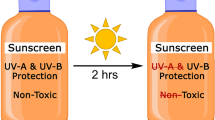Summary
We have developed a simple murine model to measure the effects on sebaceous glands of a variety of substances commonly found in topical formulations. Applications (0.2 ml) were made daily to the flanks of hairless albino female mice, for time periods varying from 4 to 9 days. Biopsies, fixed for light microscopy, were stained with H & E. Under x400 magnification, the sebocytes comprising each gland were counted, from which the mean sebocyte count per gland was calculated. Electron micrographs were prepared to evaluate sebum production. The test substances, which included anionic and cationic surfactants, solvents and emulsifiers, almost invariably led to a rapid increase in the sebocyte count, peaking at day 5. Irritating substances, such as croton oil and benzalkonium chloride, had the greatest hyperplasiogenic effect, at least doubling the sebocyte count. Electron micrographs showed large increases in rough endoplasmic reticulum and in sebum droplets. Thus, hyperplasia appears to be a stereotypic response to diverse substances, especially if these have irritancy potential.
Similar content being viewed by others
References
Abramovici A, Wolf R, Sandbank M (1968) Sebaceous gland changes following topical application of citral. Acta Derm Venereol (Stockh) 63: 428–435
Bock FG, Mund R (1956) Evaluation of substances causing loss of sebaceous glands from mouse skin. J Invest Dermatol 26: 479–482
Cunliffe WJ, Stainton C, Forster RA (1983) Topical benzoyl peroxide increases the sebum excretion rate in patients with acne. Br J Dermatol 109: 577–584
Gloor M, Kellermann H (1977) Tierexperimentelle Untersuchungen zur sebosuppressiven Wirkung von Steinkohlenteer. Dermatol Monatsschr 163: 550–555
Gloor M, Gantner M, Wirth H, Schnyder U (1980) On the influence of topically applied drugs on cell kinetics in the sebaceous gland. Dermatologica 160: 175–184
Gloor M, Klump H, Wirth H (1980) Cytokinetic studies on the sebosuppressive effect of drugs using the example of benzoyl peroxide. Arch Dermatol Res 267: 97
Goldschmidt H, Kligman AM (1968) Increased sebum secretion following selenium sulfide shampoo. Acta Derm Venereol (Stockh) 48: 489–493
Harris HH, Downing DT, Stewart ME, Strauss JS (1983) Substainable rates of sebum excretion in acne patients. J Am Acad Dermatol 8: 200–210
Kakuma T, Oshida M, Fujinawa T (1984) Application of oryzanol as a cosmetic additive. Jap J Dermatol 8: 31–33
Kligman AM, Shelley WB (1958) An investigation of the biology of the human sebaceous gland. J Invest Dermatol 30: 99–108
Kligman AM, Miller DL, McGinley KJ (1986) Sebutape: device for visualizing human sebaceous secretion, J Soc Cosm Chem 87: 369–375
McOsker DE, Beck LW (1967) Characteristics of accommodated skin. J Invest Dermatol 48: 372–383
Menton DN (1968) The effects of essential fatty acid deficiency on mouse skin. Am J Anat 122: 337–344
Orentrich N, Matias JR (1988) Local stimulation of sebaceous gland activity by topical dehydroepiandrosterone. J Soc Cosm Chem 39: 291–303
Pierard GE, Franchimont C, Le T, Lapierre C (1987) Patterns of follicular sebum excretion rate during lifetime. Arch Dermatol Res 279: 104–109
Plewig G, Steger M (1989) Acne inversa (alias acne triad, acne tetrad or hidroadenitis suppurativa). In: Cunliffe, WJ (ed) Acne and related disorders. Martin Dunitz, London pp 345–357
Schmidt JB, Neumann R, Spona J, (1985) Sebum suppression by benzoyl peroxide. Dermatologica 170: 165–172
Zackheim H (1985) Experimental basal cell cancer in the rat. In: Maibach HI, Lowe NJ (eds) Models in dermatology. S. Karger, New York, pp 89–98
Author information
Authors and Affiliations
Rights and permissions
About this article
Cite this article
Lesnik, R.H., Kligman, L.H. & Kligman, A.M. Agents that cause enlargement of sebaceous glands in hairless mice. I. Topical substances. Arch Dermatol Res 284, 100–105 (1992). https://doi.org/10.1007/BF00373378
Received:
Issue Date:
DOI: https://doi.org/10.1007/BF00373378




